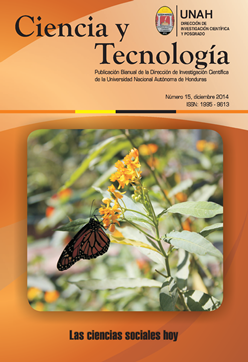Prevalencia de la resistencia genotípica a los fármacos antirretrovirales en pacientes VIH positivos de Tegucigalpa
DOI:
https://doi.org/10.5377/rct.v0i15.2174Palabras clave:
farmacorresistencia, resistencia adquirida, mutaciones, VIH-1Resumen
El objetivo de la investigación fue determinar la prevalencia de resistencia del VIH a las drogas antirretrovirales en pacientes tratados y no tratados. Para tal efecto, se analizaron 100 muestras de pacientes VIH positivos, 50 previos a iniciar tratamiento y 50 bajo tratamiento con evidencia de falla terapéutica, de Tegucigalpa.
Secuencias del gen pol del VIH-1 fueron generadas para determinar la presencia de mutaciones asociadas a resistencia, utilizando la herramienta calibrada para la vigilancia de la resistencia propuesta por la OMS para pacientes pretratados y la lista de mutaciones de la base de datos de Stanford para pacientes bajo tratamiento.
Los resultados muestran que la prevalencia de farmacorresistencia en pacientes previos a iniciar tratamiento fue del 19 % [IC 95 %: 9-33 %], el 8.3 % presentaron mutaciones contra los NRTI, el 12.5 % contra los NNRTI y el 6.25 % contra los PI. Las mutaciones con mayor frecuencia fueron: M184V, K103N, M46I. La prevalencia de mutaciones asociadas a resistencia en los pacientes en falla terapéutica fue del 82 % [IC 95 %:60-90 %], el 58 % contra los NRTI, 74 % contra los NNRTI y el 22 % contra los PI.
En conclusión, se observó un marcado aumento en la prevalencia de mutaciones asociadas a resistencia en pacientes no tratados, comparada con estudios anteriores, lo cual es de mucha preocupación, ya que limita la eficacia del tratamiento de primera línea. Aunque la prevalencia de resistencia adquirida en pacientes con falla terapéutica se mantiene ligeramente constante, sigue siendo alta, requiriendo de cambios de tratamiento a segunda o tercera línea en estos pacientes, ocasionando un impacto económico en la salud pública.
Revista Ciencia y Tecnología, N° 15, diciembre 2014: 147-160
Descargas
1330
Descargas
Publicado
Cómo citar
Número
Sección
Licencia
© Revista Ciencia y Tecnología
Este obra está bajo una licencia de Creative Commons Reconocimiento-NoComercial 4.0 Internacional.

Usted está en libertad de:
- Compartir:copiar y redistribuir el material en cualquier medio o formato
- Adaptar:remezclar, transformar y crear a partir del material
Bajo las siguientes condiciones:
- Reconocimiento: Usted debe darle crédito a esta obra de manera adecuada, proporcionando un enlace a la licencia, e indicando si se han realizado cambios. Puede hacerlo en cualquier forma razonable, pero no de forma tal que sugiera que usted o su uso tienen el apoyo del licenciante.
- Uso no comercial: Usted no puede hacer uso del material con fines comerciales.




